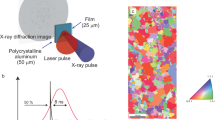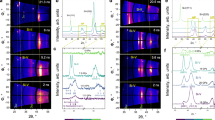Abstract
Despite its fundamental importance for a broad range of applications, little is understood about the behaviour of metals during the initial phase of shock compression. Here, we present molecular dynamics (MD) simulations of shock-wave propagation through a metal allowing a detailed analysis of the dynamics of high strain-rate plasticity. Previous MD simulations have not seen the evolution of the strain from one- to three-dimensional compression that is observed in diffraction experiments. Our large-scale MD simulations of up to 352 million atoms resolve this important discrepancy through a detailed understanding of dislocation flow at high strain rates. The stress relaxes to an approximately hydrostatic state and the dislocation velocity drops to nearly zero. The dislocation velocity drop leads to a steady state with no further relaxation of the lattice, as revealed by simulated X-ray diffraction.
This is a preview of subscription content, access via your institution
Access options
Subscribe to this journal
Receive 12 print issues and online access
$259.00 per year
only $21.58 per issue
Buy this article
- Purchase on Springer Link
- Instant access to full article PDF
Prices may be subject to local taxes which are calculated during checkout




Similar content being viewed by others
References
Itoh, M., Katayama, M. & Rainsberger, R. Computer simulation of a Boeing 747 passenger jet crashing into a reinforced concrete wall. Mater. Sci. Forum 465/466, 73–78 (2004).
Acarer, M., Gulenc, B. & Findik, F. Investigation of explosive welding parameters and their effects on microhardness and shear strength. Mater. Design 24, 659–664 (2003).
Cheng, W. L. & Itoh, S. High velocity impact of steel fragment on thick aluminum target. Mater. Sci. Forum 465/466, 49–54 (2004).
Kumar, K. S., Singh, D. & Bhat, T. B. Studies on aluminum armour plates impacted by deformable and non-deformable projectiles. Mater. Sci. Forum 465/466, 79–84 (2004).
Turtle, E. P. & Pierazzo, E. Thickness of a European ice shell from impact crater simulations. Science 294, 1326–1328 (2002).
Slavin, J. D., Jones, A. P. & Tielens, A. G. G. M. Shock processing of large grains in the interstellar medium. Astrophys. J. 614, 796–806 (2004).
Haan, S. W. et al. Design and simulations of indirect drive ignition targets for NIF. Nuclear Fusion 44, S171–S176 (2004).
Tokheim, R. E. et al. Hypervelocity shrapnel damage assessment in NIF target chamber. Int. J. Impact Eng. 23, 933–944 (1999).
Smith, C. S. Metallographic studies of metals after explosive shock. Trans. Metal. Soc. AIME 212, 574–589 (1958).
Meyers, M. A. Mechanism for dislocation generation in shock-wave deformation. Scripta Met. 12, 21–26 (1978).
Meyers, M. A. et al. Constitutive description of dynamic deformation: physically-based mechanisms. Mater. Sci. Eng. A 322, 194–216 (2002).
Gray, G. T., Hayes, D. B. & Hixson, R. S. Influence of the shock-induced alpha-epsilon transition in Fe on its post-shock substructure evolution and mechanical behaviour. J. Phys. IV 10, 755–760 (2000).
Meyers, M. A. et al. Laser-induced shock compression of monocrystalline copper: characterization and analysis. Acta Mater. 51, 1211–1228 (2003).
Vorthman, J. E. & Duvall, G. E. Dislocations in shocked and recovered LiF. J. Appl. Phys. 53, 3607–3615 (1982).
Johnson, Q., Mitchell, A. & Evans, L. X-ray diffraction evidence for crystalline order and isotropic compression during the shock-wave process. Nature 231, 310–311 (1971).
Whitlock, R. R. & Wark, J. S. Orthogonal strains and onset of plasticity in shocked LiF crystals. Phys. Rev. B 52, 8–11 (1995).
d’Almeida, T. & Gupta, Y. M. Real-time X-ray diffraction measurements of the phase transition in KCl shocked along [100]. Phys. Rev. Lett. 85, 330–333 (2000).
Rigg, P. A. & Gupta, Y. M. Multiple X-ray diffraction to determine transverse and longitudinal lattice deformation in shocked lithium flouride. Phys. Rev. B 63, 094112–094123 (2001).
Zaretsky, E. Multipeak pulse X-ray diffraction study of shocked single crystals. J. Appl. Phys. 93, 2496–2506 (2003).
Loveridge-Smith, A. et al. Anomalous elastic response of silicon to uniaxial shock compression on nanosecond time scales. Phys. Rev. Lett. 86, 2349–2352 (2001).
Kalantar, D. H. et al. Direct observation of the α-ε transition in shock-compressed iron via nanosecond X-ray diffraction. Phys. Rev. Lett. 95, 075502 (2005).
Holian, B. L. & Lomdahl, P. S. Plasticity induced by shock waves in nonequilibrium molecular-dynamics simulations. Science 280, 2085–2088 (1998).
Rosolankova, K. et al. in Shock Compression of Condensed Matter-2003 (eds Furnish, M. D., Gupta, Y. M. & Forbes, J. W.) 1195–1198 (AIP, Melville, New York, 2004).
Bringa, E. M. et al. Ultrahigh strength in nanocrystalline materials under shock loading. Science 309, 1838–1841 (2005).
Hirth, J. P. & Lothe, J. Theory of Dislocations (Wiley, New York, 1982).
Swift, D. C. & Ackland, G. J. Quantum mechanical predictions of nonscalar equations of state and nonmonotonic elastic stress-strain relations. Appl. Phys. Lett. 83, 1151–1153 (2003).
Gahagan, K. T. et al. Measurement of shock wave rise times in metal thin films. Phys. Rev. Lett. 85, 3205–3208 (2000).
Rose-Petruck, C. et al. Picosecond-milliångström lattice dynamics measured by ultrafast X-ray diffraction. Nature 398, 310–312 (1999).
von der Linde, D & Sokolowski-Tinten, K. X-ray diffraction experiments with femtosecond time resolution. J. Mod. Opt. 50, 683–694 (2003).
Mishin, Y. et al. Structural stability and lattice defects in copper: Ab initio, tight-binding, and embedded-atom calculations. Phys. Rev. B 63, 224106–224121 (2001).
Kelchner, C. L., Plimpton, S. J. & Hamilton, J. C. Dislocation nucleation and defect structure during surface indentation. Phys. Rev. B 58, 11085–11088 (1998).
Warren, B. E. X-ray Diffraction (Addison-Wesley, Menlo Park, California, 1969).
Acknowledgements
The authors would like to thank B. Sadigh for developing a faster version of MDCASK and for help with the method to obtain mobile dislocation densities, G. Gilmer for help developing the code, W. Cai and V. Bulatov and especially M. de Koning for help developing the initial dislocation sources, and the MCR and Thunder computer teams for constant help and support. We would also like to thank P. Erhart, M. Meyers, M. Schneider, J. McNaney, J. Colvin, J. Stölken, M. J. Caturla, B. D. Wirth and M. Kumar for fruitful discussions and J. Aranibar, A. Caro, and W. J. Nellis for useful comments. For the LLNL authors, this work was carried out under the auspices of the US Department of Energy by the University of California, Lawrence Livermore National Laboratory under contract No. W-7405-Eng-48.
Author information
Authors and Affiliations
Corresponding author
Ethics declarations
Competing interests
The authors declare no competing financial interests.
Supplementary information
Supplementary Information
Supplementary movie 1
Supplementary Information
Supplementary movie 2
Supplementary Information
Supplementary figure captions and movie legends
Supplementary Information
Supplementary figures S1-S4
Rights and permissions
About this article
Cite this article
Bringa, E., Rosolankova, K., Rudd, R. et al. Shock deformation of face-centred-cubic metals on subnanosecond timescales. Nature Mater 5, 805–809 (2006). https://doi.org/10.1038/nmat1735
Received:
Accepted:
Published:
Issue Date:
DOI: https://doi.org/10.1038/nmat1735
This article is cited by
-
Plasticity in diamond nanoparticles: dislocations and amorphization during loading and dislocation multiplication during unloading
Journal of Materials Science (2023)
-
In-Situ X-Ray Imaging High Strain Rate Compression of Laminate Al-Graphene Composite and Mechanical Property Characterization
JOM (2023)
-
X-ray free electron laser observation of ultrafast lattice behaviour under femtosecond laser-driven shock compression in iron
Scientific Reports (2023)
-
Ultrafast visualization of incipient plasticity in dynamically compressed matter
Nature Communications (2022)
-
Dynamic Strength of Copper at High Pressures Using Pressure Shear Plate Experiments
Journal of Dynamic Behavior of Materials (2021)



